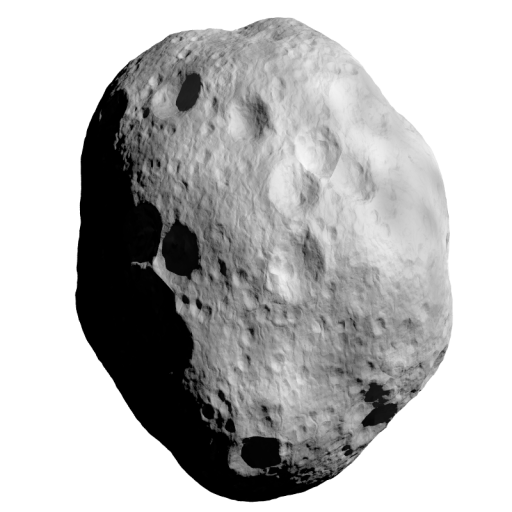Key Facts
- Categorized as a Apollo-class Asteroid
- Comparable in size to a football field (0.33 km diameter)
- Will pass within 3,934,297 km of Earth in 2021
- Classified as a Near Earth Asteroid (NEA)
- Classified as a Potentially Hazardous Asteroid (PHA)
- See orbit simulation
Overview
Nereus is a very small asteroid whose orbit crosses the orbit of Earth. NASA JPL has classified Nereus as a "Potentially Hazardous Asteroid" due to its predicted close pass(es) with Earth.
Nereus orbits the sun every 661 days (1.81 years), coming as close as 0.95 AU and reaching as far as 2.02 AU from the sun. Nereus is about 0.3 kilometers in diameter, making it larger than 90% of asteroids but tiny compared to large asteroids, comparable in size to a football field.
The rotation of Nereus has been observed. It completes a rotation on its axis every 15.17 hours.
Nereus's spectral type None (Tholen) / Xe (SMASSII) indicates that it is likely to contain iron, nickel, and cobalt.
Close Approaches
Nereus's orbit is 0.00 AU from Earth's orbit at its closest point. This means that its orbit is relatively close to Earth's orbit.
Nereus has 13 close approaches predicted in the coming decades:
| Date | Distance from Earth (km) | Velocity (km/s) |
|---|---|---|
| Dec. 11, 2021 | 3,934,297 | 6.578 |
| March 2, 2031 | 17,212,783 | 9.770 |
| Nov. 25, 2050 | 23,172,945 | 10.941 |
| Feb. 14, 2060 | 1,198,053 | 6.331 |
| Feb. 4, 2071 | 2,234,636 | 5.683 |
| Nov. 25, 2081 | 24,080,726 | 11.160 |
| Feb. 27, 2102 | 10,925,848 | 8.432 |
| Dec. 23, 2112 | 2,671,066 | 5.789 |
| Nov. 27, 2123 | 23,261,471 | 10.966 |
| Feb. 28, 2155 | 12,486,050 | 8.737 |
| Feb. 3, 2166 | 2,759,036 | 5.594 |
| Nov. 25, 2176 | 25,391,489 | 11.427 |
| Feb. 26, 2197 | 9,565,542 | 8.127 |
Images and Observations
Nereus's orbit is determined by observations dating back to Sept. 30, 1981. It was last officially observed on May 31, 2022. The IAU Minor Planet Center records 4,952 observations used to determine its orbit.
Accessibility and Exploration
Nereus can be reached with a journey of 426 days. This trajectory would require a delta-v of 10.37 km/s. To put this into perspective, the delta-v to launch a rocket to Low-Earth Orbit is 9.7 km/s. There are 1,583 potential trajectories and launch windows to this asteroid.
See more at the NHATS Mission Trajectories table for Nereus.
Similar Objects
These objects have orbits that share similar characteristics to the orbit of Nereus:References
Search
or view a random objectOrbital Elements
- Epoch: 2460200.5 JD
- Semi-major axis: 1.485 AU
- Eccentricity: 0.3587
- Inclination: 1.45°
- Longitude of Ascending Node: 313.12°
- Argument of Periapsis: 159.51°
- Mean Anomaly: 334.14°
Physical Characteristics
- Diameter: 0.33000 km
- Magnitude: 18.75
- Albedo: 0.55
- Spectral type (SMASS): Xe
Derived Characteristics
- Orbit Period: 661 days (1.81 years)
- Avg. Orbit Speed: 24.44 km/s
- Aphelion Distance: 2.02 AU
- Perihelion Distance: 0.95 AU
- Rotation Period: 15.17 hours
- Approx. Composition: iron, nickel, and cobalt.
Map Comparison
Orbit Simulation
Sky Map
The position of Nereus is indicated by a ◯ pink circle. Note that the object may not be in your current field of view. Use the controls below to adjust position, location, and time.
Size Rendering
The below comparison is an artistic rendering that uses available data on the diameter of Nereus to create an approximate landscape rendering with New York City in the background. This approximation is built for full-resolution desktop browsers. Shape, color, and texture of asteroid are imagined.

